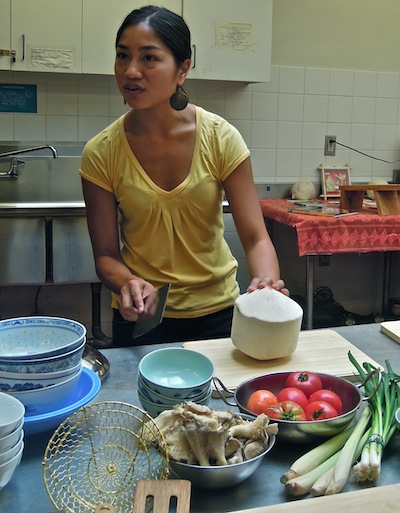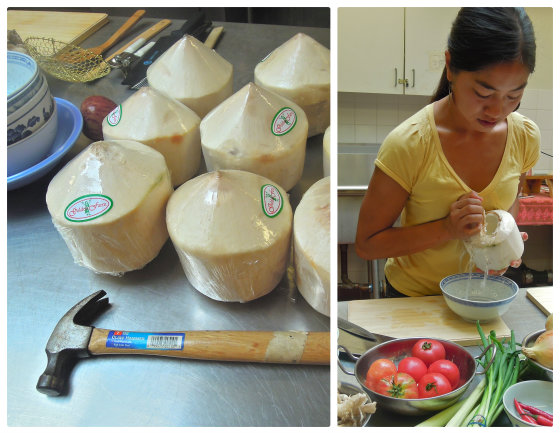Aileen Suzara, a 2nd generation Filipina American, guided eight of us through three coconut-centric recipes from her culture:
Binakol: a chicken soup, featuring fresh coconut water, shallot, garlic, ginger, mushrooms and young coconut slices.
Laing: a green vegetable dish traditionally made with taro leaves, coconut milk and chilis. Suzara opted for fresh kale leaves instead of taro and upped the ante with coconut cream, plus plenty of garlic and ginger.
And for dessert, Palitaw: simple rice flour dumplings rolled in sesame seeds and chopped coconut.
To round out the meal, she shared some precious heirloom black rice a friend had brought back from the Philippines.
Against a background of resounding drumbeats from OACC’s Lion Dance class next door, Suzara demonstrated the ease of cracking open the stocky, young coconuts. A few decisive whacks of a cleaver, and coconut water came gushing forth. Then she showed how easy it is to scoop out the soft, slimy white flesh with just a spoon. While some of us scraped out coconut meat, others chopped ginger, as directed by Suzara, “in pieces big enough to slap you in the face with a burst of ginger.”
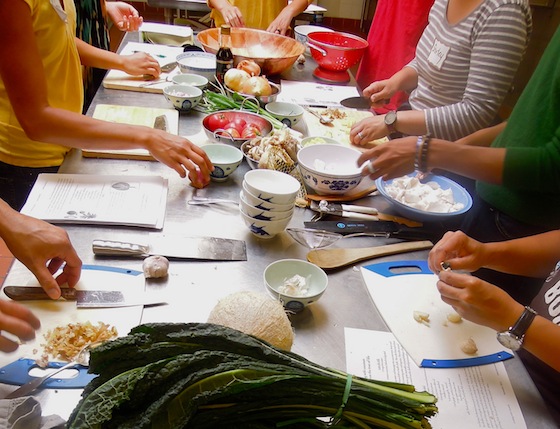
As soon as Suzara spooned a dollop of coconut oil into the hot wok, followed by the chopped shallots, ginger and garlic, a symphony of aromas filled the room. Chicken thighs browned and then slowly simmered in the coconut water collected from the half-dozen young coconuts. Black peppercorns, and lemongrass were added to the soup and finally oyster mushrooms and the white coconut meat.
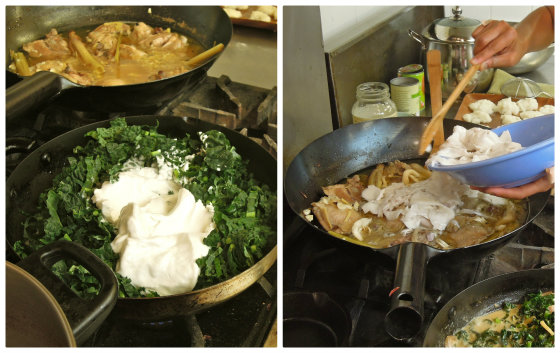
Adding coconut cream to the laing and young coconut meat to the binakol
Suzara, who encouraged us to cook with our senses instead of relying exclusively on recipes, modeled how to cheerfully roll with the punches of a few kitchen mishaps. These “teaching moments” -- as she referred to the pop-up surprises -- included: a little cut here, a minor burnt wooden board there and a rice flour mixture that was too liquid, so she changed desserts mid-course.
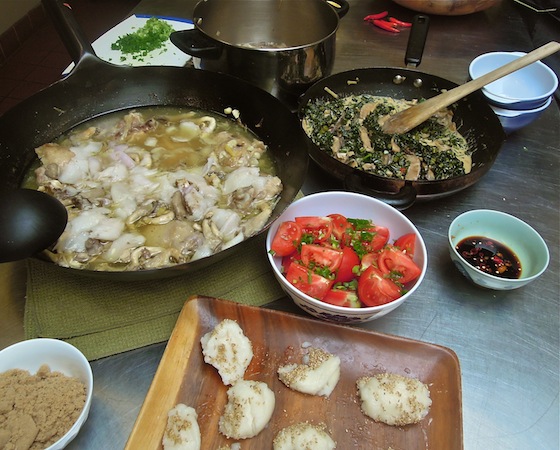
Our lunch of binakol, laing and palitaw
While we enjoyed our collectively created lunch, Suzara shared a little about herself. After studying environmental science, she worked with non-profits on environmental re-education, catered Filipino cooking and completed a program at UC Santa Cruz in ecological horticulture.
She is active in social justice and agricultural education and wants to help her community make wise food choices. She cites the impact that 400 years of Spanish and US colonization has had on the traditional Filipino diet, resulting in, for example, a switch to refined flour and convenience foods and fried dishes which were traditionally enjoyed for just for special celebrations (like lumpia) that have become defining dishes of the cuisine.
(This reminded me of a similar struggle in African American food culture portrayed in the film, Soul Food Junkies.)
As we cleaned up the kitchen, I interviewed Suzara about how she learned to cook Filipino food, her involvement in agricultural education and her future plans.
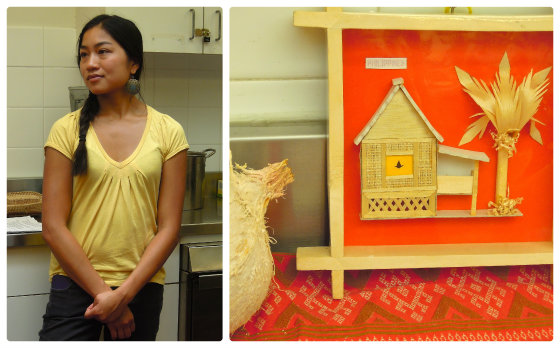
Why did you pick coconut as the focus of this class?
Coconut is close to my heart. My father is from Bicol, a region of the Philippines famous for its coconut dishes, so cooking with coconut is in my blood. In the Philippines, coconut is called the “Tree of Life” because you can use every part of it. Its trunk and leaves provide building materials and home décor, its oil is used in beauty products and is very healthy for cooking, coconut sugar is better for diabetics and coconut milk is used all over South East Asia, the Philippines and the Pacific Islands.
I grew up in five different states but spent my adolescence on The Big Island Hawaii, so I ate the local coconuts there. When I was a freshman, they held a school “Olympics” with running and swimming events but somehow even though I was the scrawniest 14-year old, they put me in the coconut cracking and husking competition. Of course, I was slower and lost to a bunch of big boys, but I got the process down.
Did you learn to cook Filipino specialties from your parents?
Yes and no, I’m somewhat self-taught. My hardworking parents worked long hours as a nurse and doctor. When I was about eight, they gave me free reign in the kitchen and I started cooking for the family. At first I did scrambled eggs but later moved on to soups and stews. Then I found some old Filipino cookbooks, including one that my mom brought when she immigrated at 23. It was in English but there were all these words for ingredients that I had never seen before. I wanted to learn what it all meant.
Growing up, meals were flavored by my parents’ ‘post-WWII diet’ of American imports -- things like Spam, Vienna sausage, corned beef -- and of course, fish and rice. So that’s the kind of thing they cooked. But when I was eight, we took a trip back to the Philippines and I met my grandparents and extended family. They took me to these huge markets. I tasted everything and fell in love.
Didn’t you just come back from living and working on a farm?
Yes, first, I spent six months in an apprenticeship program at UC Santa Cruz in ecological horticulture. (Here’s a video from the Filipino channel interviewing Aileen about her experience working on the organic farm.)
ADOBO NATION. Sustainable Farming. from Jeremiah Ysip.
And I just returned from Pie Ranch, an educational farm in Pescadero with a youth program that teaches young people to learn where their food comes from. I helped care for their 250 chickens, goats and 15+ acres of wheat, squash and other crops.
What are some of your future plans?
If there’s anything I learned from experiences in the food world, it’s that we need more culturally relevant models. I hope to be part of developing new programs to engage Asian-Pacific youth. Filipinos have a long history of leadership in the food movement that unfortunately, not enough people are aware of. In the early 1900s thousands came and worked on California farms. And while many people have heard of the United Farm Workers, they may not know of Filipino organizers like Larry Itliong, who worked alongside Cesar Chavez and co-founded the movement.
I’d like to grow traditional ingredients used in Filipino cuisine and work with my community for more access to healthy fresh food and on health issues linked to food. It’s the immigrant paradox, as what we may now think of as a typical Filipino diet has steered away from plant-based foods, which have always been part of our traditions, one reason why heart disease, type 2 diabetes and hypertension have all become so common.
I just moved back to Oakland. This week, I start my new job as Garden Coordinator for a green school program at a San Francisco elementary school.
Watch for Aileen Suzara to teach more classes at OACC and share her cooking in a pop-up sponsored by Oakland’s People's Kitchen to celebrate Filipino American History Month in October. And on October 13, catch her at a Litcrawl Reading at Irma's (one of San Francisco's oldest Filipino restaurants), sponsored by PAWA (Philippine American Writers and Artists).
